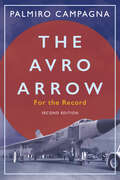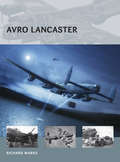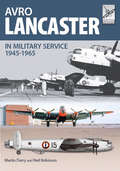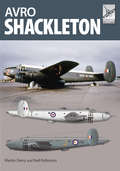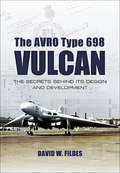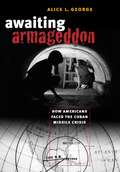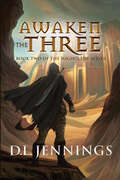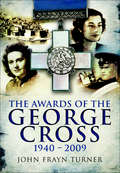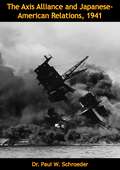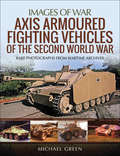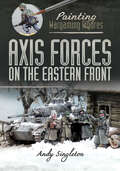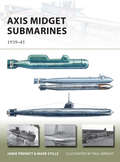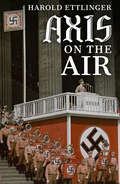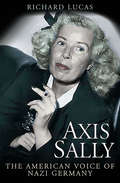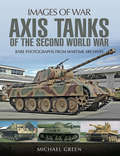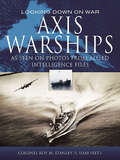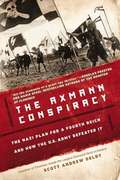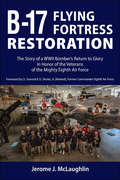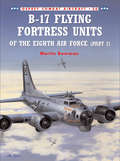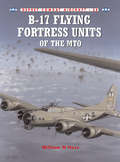- Table View
- List View
The Avro Arrow: For the Record
by Palmiro Campagna“No one has done more than Palmiro Campagna to document the story of Canada’s extraordinary Avro Arrow ... This latest work sheds new light on the Arrow’s fascinating saga.” — ANDREW CHAIKIN, author of A Man on the MoonAn expanded edition of the bestselling book, including newly discovered American records that shed further light on the disastrous cancellation of the Avro Arrow. The controversial cancellation of the Avro Arrow — an extraordinary achievement of Canadian military aviation — continues to inspire debate today. When the program was scrapped in 1959, all completed aircraft and those awaiting assembly were destroyed, along with tooling and technical information. Was abandoning the program the right decision? Did Canada lose more than it gained?Brimming with information to fill the gaps in the Arrow’s troubled history, this new edition also brings to light recently discovered documents that answer whether the United States government wished Canada to continue the development of what was considered the world’s most advanced interceptor aircraft.
Avro Lancaster
by Adam Tooby Richard MarksThe Avro Lancaster was one of the finest bombers of World War II and became the spearhead of the RAF's strategic bombing campaign over the Third Reich. Richard Marks draws on extensive research and detailed technical drawings to explore the evolution of this heavy bomber, revealing how its design developments transformed an old airframe from a dangerous liability to one of the most powerful weapons in the RAF arsenal. The lifespan of the Lancaster began with the troublesome Avro Manchester design, an aircraft that had promised much but proved hazardous to crews. The 'Lanc' retained the Manchester's basic airframe, but was given four Rolls-Royce Merlin engines instead of the two, underpowered and unreliable powerplants fitted to its predecessor. As soon as the first prototype flew, it demonstrated excellent performance, ruggedness and good handling qualities and it was soon at the fore of all the RAF's bombing campaigns. It captured imagination as the aircraft that flew in the famous 'Dambuster' attacks, but most importantly, once available in sufficient numbers, the Lancaster gave Bomber Command the tool with which it could strike at targets almost anywhere in Germany. This book tells the story of the iconic Lancaster in full, providing a comprehensive account of the design, development and operational history of the aircraft and its evolution into successor aircraft.
Avro Lancaster in Military Service, 1945–1965: In British, Canadian And French Military Service
by Martin Derry Neil RobinsonThe Avro Lancaster, such a stalwart of the skies during the Second World War, also enjoyed an interesting and surprisingly colourful post-war career. It is this era that the authors have chosen to focus on by profiling the type across its many variants.Split into three primary sections, this book offers a concise yet informative history of the Lancaster's post-war operational career (from 1945-1965) charting the course of the various alterations and improvements that occurred during this time and including a selection of contemporary photographs with detailed captions. A 16-page section features 32 colour illustrations (in profiles, 2-views and 4-views) specially prepared by Mark Gauntlett. The book's final section provides a list and box top illustrations of the plastic model kits produced of the Lancaster in all scales plus reviews and 'how to' construction notes on building a selection of kits in 1/144, 1/72 and 1/48 scales. As with the other books in the Flight Craft series, whilst published primarily with the scale aircraft modeller in mind, it is hoped that those readers who might perhaps describe themselves as 'occasional' modellers - if indeed they model at all - may also find that this colourful and informative work offers something to provoke their interests too.
Avro Shackleton
by Martin Derry Neil RobinsonInitially projected as a maritime reconnaissance version of the Lincoln bomber, itself a development of the famous wartime Lancaster which saw post-war service in a General/Maritime Reconnaissance role, (see Flight Craft No 4), the Avro Shackleton, (named after the polar explorer Sir Ernest Shackleton) was a completely new design, powered by four Rolls Royce Griffon 57 engines driving six blade contra-rotating propellers.Split into three main sections, this latest Flight Craft title, perfectly timed to coincide with the release of the first examples of the eagerly awaited new tool 1/72 scale Airfix kit, offers a concise history of the Shackleton's development and operational career from the prototype and initial entry in to RAF service in 1951, and its use with the South African Air Force, the only other operator of the type. Section 1 chronicles its design, ongoing improvements and development through the three main Marks, in both the Maritime Reconnaissance and Airborne Early Warning roles, until its retirement after four decades of RAF service in 1991, which includes scores of contemporary photographs with detailed captions, many of which have never been seen in print before.This is followed by a 16-page colour illustration section featuring profiles and 2-views of the colour schemes and markings carried by the type in RAF and SAAF service. The final section lists all the plastic model kits, accessories and decal sheets produced of the Shackleton in all scales. As with the other books in the Flight Craft series, whilst published primarily with the scale aircraft modeller in mind, it is hoped that those readers who might perhaps describe themselves as 'occasional' modellers may also find that this colourful and informative work offers something to provoke their interests too.
The Avro Type 698 Vulcan: The Secrets Behind its Design and Development
by David W. FildesThe Avro Vulcan was the last V Bomber to see active service in its primary role during the Falklands conflict. It is the most popular of the three and one aircraft has recently become airborne again after a long period of rejuvenation. It has always been a major attraction at air shows throughout the world, attracting crowds who delight in its unique delta-wing shape and amazing maneuverability.The book examines the origins of the design, the prototypes and experimental aircraft, and goes on to explain the modifications that were made to the last of the breed.A leading member of the Avro Historical Society, the author has discovered many photographs and experimental design plans in their archives which are here published for the first time.
Awaiting Armageddon
by Alice L. GeorgeFor thirteen days in October 1962, America stood at the brink of nuclear war. Nikita Khrushchev's decision to place nuclear missiles in Cuba and John F. Kennedy's defiant response introduced the possibility of unprecedented cataclysm. The immediate threat of destruction entered America's classrooms and its living rooms. Awaiting Armageddon provides the first in-depth look at this crisis as it roiled outside of government offices, where ordinary Americans realized their government was unprepared to protect either itself or its citizens from the dangers of nuclear war.During the seven days between Kennedy's announcement of a naval blockade and Khrushchev's decision to withdraw Soviet nuclear missiles from Cuba, U.S. citizens absorbed the nightmare scenario unfolding on their television sets. An estimated ten million Americans fled their homes; millions more prepared shelters at home, clearing the shelves of supermarkets and gun stores. Alice George captures the irrationality of the moment as Americans coped with dread and resignation, humor and pathos, terror and ignorance.In her examination of the public response to the missile crisis, the author reveals cracks in the veneer of American confidence in the early years of the space age and demonstrates how the fears generated by Cold War culture blinded many Americans to the dangers of nuclear war until it was almost too late.
Awaken the Three: Book Two Of The Highglade Series (The Highglade #2)
by D. L. JenningsIn the sequel to his award-winning novel Gift of the Shaper, D. L. Jennings once again brings to life an epic tale of war and chaos as earthly armies fight for otherworldly prizes. Beyond the Wastes of Khulakorum, a storm is rising . . . The Shaper of Ages is gone, and along with her, the Breaker -- yet gods are not the only threat to the peace of the living. Aldis Tennech, the once-great general of the armies of Gal'dorok, finds himself in exile. His only hope of reclaiming glory lies in the hands of a self-proclaimed emperor, and the unearthly powers that put him there. Meanwhile, improbable alliances are forged in the north as unexpected enemies rear their heads and threaten ruin-with a single thread in common, connecting them all. In the sequel to his award-winning novel Gift of the Shaper, D. L. Jennings once again brings to life an epic tale of war and chaos as earthly armies fight for otherworldly prizes. Ancient powers lying dormant must be called upon, bringing strength to those who need it and conquest to those who seek it; battles will rage and cities will fall, but only the most desperate or reckless would seek . . . . . . to awaken the three.
The Awakened Mage: Kingmaker, Kingbreaker: Book 2 (Kingmaker, Kingbreaker #2)
by Karen Miller'A writer who seems to set the rule for the genre' - Waterstones Books Quarterly'Miller is clearly a very talented writer: her characterisation is a masterclass in nuance and sensitivity, and she has a visceral way with action' - SFXPrince Gar now has the magic for weatherworking and is able to keep his enemies at bay, while Asher has become the most powerful Olken in the history of Lur. Peace and prosperity seem assured for the two of them. But Morg, the evil sorcerer mage, remains trapped inside a shattered body. He knows his time is running out and that desperate measures are called for.Unwittingly, Gar and Asher become caught up in a dangerous deception which threatens to tear apart the kingdom and destroy the fragile balance between Olken and Doranen.And no one, not even Dathne and her secret Circle, is prepared for the consequences when the Innocent Mage is revealed at last . . .Following The Innocent Mage, this is the second and concluding volume in the bestselling Kingmaker, Kingbreaker series - a wildly fast-paced fantasy brimming with action and adventure.Books by Karen Miller:Kingmaker, Kingbreaker SeriesThe Innocent MageThe Awakened MageA Blight of MagesGodspeakerEmpress of MijakThe Riven KingdomThe Hammer of GodFisherman's ChildrenThe Prodigal MageThe Reluctant MageTarnished CrownThe Falcon ThronePrince of Glass
The Awakening
by Allen JohnsonHow do you find love where love does not exist?From out of a barefoot boyhood among endless rows of olive trees, and a forbidden passion for a courageous Moroccan beauty, to a horrific struggle against tyranny in the war-torn streets of 1936 Granada, comes a story where love cannot exist without mercy . . . mercy one carries for one's whole life as a badge of honor . . . mercy and compassion passed down from generation to generation.Diego Garcia is now the gentle patriarch in a sun-scorched village perched among the rolling hills and olive groves of Andalusia, Spain. Diego survived the bloody Spanish Civil War only at great cost, and his enduring wish is that he could have saved others. His granddaughter, the lovely Lupita, is the town's physician, whose competence is surpassed only by her compassion. Together they breathe new life into a mysterious American stranger, brutally beaten and robbed, suffering from amnesia, whose suppressed past is so scarred by his own malice and deceit that he dare not awaken-save through the guiding grace of love.Together, the three forge a new beginning and find redemption in trust, love, and acceptance of the past . . . a past they would do anything to leave behind.
Awakening Victory: How Iraqi Tribes and American Troops Reclaimed Al Anbar and Defeated Al Qaeda in Iraq
by Michael SilvermanIn August 2006, many senior U.S. officials thought America had lost the war in Iraq, as the senior U.S. Marine Corps intelligence officer there wrote that control of al Anbar Province, the seat of the raging Sunni insurgency, was irrevocably lost to the insurgents. During that time, there were over 100 attacks per day against U.S. military and Iraqi forces in al Anbar, and al Qaeda in Iraq had planted their flag in the provincial capital, Ramadi, declaring it the capital of their new &“Islamic State of Iraq.&” In January 2007, as a spearhead of the newly decided &“Surge,&” the 3rd Battalion, 69th Armored Regiment deployed to Ramadi as part of the 3rd Infantry Division, the first regular Army unit to deploy to Iraq for a third time. The battalion and its parent brigade went to work in a campaign that will be seen as the D-Day of the Global War on Terror. Starting by clearing al Qaeda from the city of Ramadi and replacing them with legitimate locally raised and trained Iraqi police—while simultaneously fostering the tribal movement known as the &“Awakening Councils&”—the brigade began to have tremendous success. By April 2007, attacks within Ramadi went from twenty per day to one or two per week. By mid-summer 2007, attacks in the entire province were down 90 percent from 2006. Furthermore, the &“Awakening&” had swept through the rest of Iraq, leading to the best security situation seen since 2003. The 3rd Battalion, 69th Armored, was the only battalion to participate in this campaign from start to finish. Moreover, many of the US successes came directly from this unit&’s work. Awakening Victory tells the story of this incredible campaign through the eyes of the commander of the 3rd Battalion, who was right in the thick of the fight. The book also provides a description of the Iraqi insurgency—particularly al Qaeda in Iraq—that offers the depth and texture which are currently lacking in most Americans' perceptions of the war. It describes the battalion&’s actions, including incidents previously unknown to the public, but it is not merely another blood-and-guts war story. The author uses the actions of his battalion to describe a paradigm shift that occurred, while in a totally foreign culture, yet allowed for a move from a war of bombs and bullets to one of partnership and ideas. The author, Lt. Col. Michael E. Silverman (ret) is a political scientist and historian by education and has extensive experience in both warfare and Middle Eastern affairs, including a tour as an advisor to a Saudi Arabian infantry battalion in Riyadh. Silverman served a two-year detail to the Central Intelligence Agency at their Langley headquarters between his last two tours in Iraq. There he was privy to the Director&’s Weekly Iraq Briefing, a working group that discussed issues on the war, many of which ultimately found their way into the President&’s Daily Briefing. Well-versed in international affairs and world religions, he writes with the authority of someone who has both been blown-up by an IED and helped to shape US strategic policy for the Global War on Terror. In this book he describes, from the very front line, the exact turning point where the United States turned a supposedly failed war into a possibly enduring success.
The Awards of the George Cross, 1940–2009: 1940-2009
by John Frayn TurnerEarly in WW2, King George VI was deeply impressed by the heroic deeds of servicemen out of the front line and civilian non-combatants in acts connected with the war such as bomb disposal and rescues after air raids. So in September 1940 the King instituted the George Cross for For Gallantry away from the heat of actual battle, to be awarded to civilians and servicemen and women. As the war progressed, the range of deeds increased. In April 1942 the unprecedented award of the GC was made to the entire population of the Island of Malta to honor her brave people. Later the award was made for supreme gallantry to members of the Special Operations Executive, including Violette Szabo and Forest Yeo-Thomas (The White Rabbit). Many were posthumous. The George Cross continued to be awarded in the post war years and up to the present day, and this fine books covers all of these.
The Axis Alliance and Japanese-American Relations, 1941: American Relations 1941
by Dr Paul W. SchroederThe Japanese attack on Pearl Harbor on December 7, 1941 is remembered by Americans as something like a bolt out of the blue, a sneak attack from an irrational enemy. The truth, however, is that the Japanese attack was preceded by six months of intense diplomatic negotiations between the Japanese and the Americans.In The Axis Alliance and Japanese-American Relations, historian Paul Schroeder reviews the course of these negotiations. Of particular interest to Schroeder is the role that Japan’s Tripartite Pact with fascist Italy and Nazi Germany played in the negotiations.Schroeder shows that Japan, far from entering an alliance for world domination with Hitler, viewed the pact as an opportunity to secure its interests while avoiding a war with the U.S. and how, when the Pact became a liability in Japan’s negotiations with America, the Japanese were quick to downplay their dedication to it and its importance in their policies. Schroeder also observes the other primary issues at stake in the negotiations—Japan’s war with China and its expansionary intentions in the Pacific—and discusses how American diplomacy wasted many opportunities to not only avoid war in the Pacific, but secure concessions from Japan.This book, a scholarly reconsideration of American policy leading up to the war, is notable for its balance and accuracy and for its revisionist conclusions that are wholly supportable by the facts.
Axis Armoured Fighting Vehicles of the Second World War (Images of War)
by Michael GreenDuring the Second World War the Axis powers, most prolifically the Germans, deployed a vast array of armored fighting vehicles to support their tanks and infantry. These included tank destroyers, reconnaissance vehicles, flame-thrower vehicles, and self-propelled artillery pieces. Armored tank destroyers, such as the Marder series, the Nashorn, Jagdpanther, Jagdtiger and the turretless German Stu III series (based on the Panzer III medium tank), helped the Nazis overcome their shortage of tanks. Copying the Stu III series the Italians created the turretless Semovente da 75/18 assault gun and the Hungarians the turretless Zrinyi. In the role of self-propelled artillery the German fielded the Hummel, the Wespe and the Grille while the Brummbar and the Sturmtiger performed in the dedicated assault gun role. For armored reconnaissance German industry came up with a series of capable armored cars; examples were the eight-wheel Puma and the full-tracked Luchs reconnaissance tank. The Italians developed the impressive four-wheel Autoblinda armored cars. Specialized antiaircraft tanks such the Mobelwagen, Wirbelwind and the Ostwind gave some protection against the ever more powerful Allied air forces. This fine book covers all these variants and many more besides in words and rare images and will delight readers, collectors, model-makers and war-gamers.
Axis Armoured Fighting Vehicles of the Second World War: Rare Photographs From Wartime Archives (Images of War)
by Michael GreenDuring the Second World War the Axis powers, most prolifically the Germans, deployed a vast array of armored fighting vehicles to support their tanks and infantry. These included tank destroyers, reconnaissance vehicles, flame-thrower vehicles, and self-propelled artillery pieces. Armored tank destroyers, such as the Marder series, the Nashorn, Jagdpanther, Jagdtiger and the turretless German Stu III series (based on the Panzer III medium tank), helped the Nazis overcome their shortage of tanks. Copying the Stu III series the Italians created the turretless Semovente da 75/18 assault gun and the Hungarians the turretless Zrinyi. In the role of self-propelled artillery the German fielded the Hummel, the Wespe and the Grille while the Brummbar and the Sturmtiger performed in the dedicated assault gun role. For armored reconnaissance German industry came up with a series of capable armored cars; examples were the eight-wheel Puma and the full-tracked Luchs reconnaissance tank. The Italians developed the impressive four-wheel Autoblinda armored cars. Specialized antiaircraft tanks such the Mobelwagen, Wirbelwind and the Ostwind gave some protection against the ever more powerful Allied air forces. This fine book covers all these variants and many more besides in words and rare images and will delight readers, collectors, model-makers and war-gamers.
Axis Forces on the Eastern Front (Painting Wargaming Figures)
by Andy SingletonFull of practical tips and useful advice on materials and techniques for the beginner.Andy Singleton has been modeling and painting most of his life and has been a professional commission figure painter for some years now. Here he shares his experience and tips of the trade for painting Axis forces on WW2’s Eastern Front: Germans, Romanians, Hungarians and Italians and Finns. Each of the chapters is broken into step by step guides explaining the steps and colors required to paint the various uniforms used. The emphasis is on quickly achievable results and practical advice that is applicable to painting units or whole armies for wargaming purposes in a reasonable time frame. The techniques described are designed to easily be adaptable to figures of all sizes. Andy’s clear, step-by-step guidance is primarily designed for those new to historical gaming, and takes the reader through the process from the initial preparation and assembly of the figure, to finishing and basing.
Axis Midget Submarines
by Mark Stille Paul WrightDuring World War II, Germany, Japan, and Italy built approximately 2,000 small, inherently stealthy, naval craft to perform special operations and conventional naval missions. Much more numerous and more technically advanced than their Allied counterparts, they saw service worldwide, operating in the Pacific, Mediterranean, Black Sea, Indian Ocean, North Sea, and the English channel. Manned by courageous crews, these vessels made daring attacks on Allied ships in heavily protected anchorages using torpedoes and mines. Most notable were attacks against Gibraltar - launched from an Italian cargo vessel interred in nearby neutral Spain that had been converted into a clandestine support base and equipped with an underwater hatch - and Pearl Harbor. They were used against shipping in coastal waters and, near the end of the war, in desperate attempts to offset their opponents' overwhelming naval superiority during the US advance across the Pacific and the Allied amphibious landings in France and Italy. This volume will detail the history, weapons, and operations of German, Japanese, and Italian midget submarines.
Axis on the Air
by Harold L. EttlingerThe Axis on the Air, first published in 1943, is a fascinating look at the use of radio for propaganda purposes by the Nazis, Japanese, and Italians during World War II. Author Harold Ettlinger, a columnist for the Chicago Sun, provides insight and numerous examples of Nazi Propaganda Minister Goebbels, famous traitors such as “Lord Haw Haw,” Jane Anderson, and Ezra Pound, and Axis broadcasts to its own citizens as well as efforts to create unrest and lower morale in England and the United States. The book also examines Allied radio services such as the BBC and Voice of America, plus radio stations in some of the smaller European countries such as Sweden and Finland.A vivid, authentic description of how the Axis, led by Goebbels, has used the radio as a weapon for subjugating its enemies.
Axis Sally: The American Voice of Nazi Germany
by Richard LucasA &“fascinating, well-researched account&” of Mildred Gillars, the failed actress who turned on her country and became a Nazi propagandist during WWII (Publishers Weekly). One of the most notorious Americans of the twentieth century was a failed Broadway actress turned radio announcer named Mildred Gillars (1900–1988), better known to American GIs as &“Axis Sally.&” Despite the richness of her life story, there has never been a full-length biography of the ambitious, star-struck Ohio girl who evolved into a reviled disseminator of Nazi propaganda. At the outbreak of war in September 1939, Gillars had been living in Germany for five years. Hoping to marry, she chose to remain in the Nazi-run state even as the last Americans departed for home. In 1940, she was hired by the German overseas radio, where she evolved from a simple disc jockey and announcer to a master propagandist. Under the tutelage of her married lover, Max Otto Koischwitz, Gillars became the personification of Nazi propaganda to the American GI. Spicing her broadcasts with music, Gillars&’s used her soothing voice to taunt Allied troops about the supposed infidelities of their wives and girlfriends back home, as well as the horrible deaths they were likely to meet on the battlefield. Supported by German military intelligence, she was able to convey personal greetings to individual US units, creating an eerie foreboding among troops who realized the Germans knew who and where they were. After broadcasting for Berlin up to the very end of the war, Gillars tried but failed to pose as a refugee, and was captured by US authorities. Her 1949 trial for treason captured the attention and raw emotion of a nation fresh from the horrors of the Second World War. Gillars&’s twelve-year imprisonment and life on parole, including a stay in a convent, is a remarkable story of a woman who attempts to rebuild her life in the country she betrayed.
Axis Tanks of the Second World War (Images of War)
by Michael GreenThis pictorial history presents an in-depth study of the various tanks built and deployed by the Axis Alliance during WWII. Though Nazi Panzer tanks have become a ubiquitous symbol of Axis Alliance combat, the Japanese Army had more tanks than Germany in 1938. These included the Type 95 light tank and the Type 89 and 97 medium tanks. Other Axis powers, including Italy, Romania and Hungary also built their own tanks. The latter was responsible for the Toldi and Turan light tank series. In this informative collection of wartime photographs, military expert Michael Green discusses how the Axis powers drew on British and French tank designs in the period leading up to the Second World War. The Carden-Loyd tankette suspension was used as a model for the Panzer 1 series as well as the light Italian and Japanese tanks. German engineering talent then produced the ingenious designs of the Panzer II, III and IV series and, later in the War, the Panther Medium and Tiger heavy tanks.
Axis Warships: As Seen on Photos from Allied Intelligence Files (Looking Down on War)
by Colonel Roy M. Stanley IIFor his latest book Colonel Roy Stanley presents aerial photographs of the German and Italian fleets that were selected as important six decades ago and have long lain dormant, unindexed and unexplained. Extensive use of aerial and other Intelligence imagery from long retired files would be enough to make this book a must for those intrigued by World War II intelligence and naval history. But it is the author's commentary that makes this work truly unique, thanks to his aerial photo interpretation experience, ability to provide Intelligence analysis, and academic background. Meticulously researched for ship identification, the eye of an experienced PI sees things others might miss, and the author tells us what he sees. Some of these photos may have appeared in contemporary documents but never with the insight presented in this book. We see warships under attack, at sea and in harbor as captured by photo reconnaissance. Analysis of selective enlargements adds to the understanding. Even the most devout follower of warships will learn something.
The Axmann Conspiracy
by Scott Andrew SelbyBerlin, 1945: Artur Axmann--a trusted member of Hitler's inner circle and leader of the Hitler Youth--witnesses the Führer commit suicide. But he would not let the Reich die with its leader . . . Evading capture, and with access to remnants of the regime's wealth, Axmann had enough followers to reestablish the Nazi party in the very heart of Allied-occupied Germany--and position himself to become dictator of a Fourth Reich. U.S. Army Counter Intelligence Corps Officer Jack Hunter was the perfect undercover operative. Fluent in German, he posed as a black marketeer to root out Nazi sympathizers and saboteurs after the war, and along with other CIC agents uncovered the extent of Axmann's conspiracy. It threatened to bring the Nazis back into power--and the task fell to Hunter and his team to stop it. The Axmann Conspiracy is the true story of the Nazi threat that continued in the wake of World War II, the espionage that defeated it, and two fascinating men whose lives forever altered the course of history. INCLUDES PHOTOGRAPHS AND MAPS
Aztechs
by Lucius ShepardIn Aztechs, Shepard returns to the near-future setting of his Nebula Award-winning story, "R&R" (later part of Life During Wartime). El Rayo, the bustling border community grown up along the electrified fence along the U.S./Mexican border, is home to Eddie Poe, who earns his living by providing security. The men he hires are AWOL U.S. soldiers. AZTECH, a mysterious high-tech firm rumored to be run by a renegade U.S. military AI named Montezuma, hires Eddie and his bodyguards to join AZTECH representative Montezuma 2 ("Z2") for a meeting with the Carbonell cartel. When the meeting goes sour and Z2 is badly wounded, one of the soldiers lobs a pocket nuke to cover their escape, and Eddie realizes he's no longer in control...
B-17 Flying Fortress Restoration: The Story of a WWII Bomber's Return to Glory in Honor of the Veterans of the Mighty Eighth Air Force
by Jerome J. McLaughlinThe arrival of the WWII B-17 bomber at the National Museum of the Mighty Eighth Air Force in January of 2009 ini-tiated a great adventure for a group of warbird lovers from the nearby commu-nities as they united to restore that B-17. The dream of the volunteers was to honor the WWII veterans of the Eighth Air Force – some of whom were literally their fathers – by restoring the B-17 to its original pristine condition. The group was challenged by the fact that the airplane had been in storage for more than two decades following a long working life, and was far from the gleaming symbol of power that it had been in 1945. This book is the story of the six year effort by a team of volunteers to over-come the challenges they faced and to fulfill their dream to create a lasting sym-bol to honor their fathers and grandfa-thers and all of the veterans who served in the Mighty Eighth during WWII.
B-17 Flying Fortress Units of the Eighth Air Force (part #2)
by Mark Styling Martin BowmanThe Boeing B-17, which has come to epitomise the American war effort in Europe during World War II (1939-1945), took the fight to Germans from the late summer of 1942 through to VE-Day. Its primary operator in Western Europe was the 'Mighty Eighth', who controlled 27 bomb groups for much of the war. This second of two volumes covers the 14 Bomb Groups of the Third Air Division. First hand accounts, period photography, profile artworks and nose art scrap views bring to life aircraft from each of the groups within the Third Air Division.
B-17 Flying Fortress Units of the MTO
by Mark Styling William HessOsprey's study of the B-17 Flying Fortress Units of World War II (1939-1945). Although the Fifteenth Air Force was dismissed as 'minor leaguers' by the Eighth Air Force, strategic bombers from this outfit had done a 'major league' job on Axis targets in southern Europe following its formation in Italy in November 1943. And the heavy bombers employed by the Fifteenth were of course the venerable B-17 and B-24. At its peak strength, the Fifteenth's B-17 force comprised six groups of four squadrons each, all controlled by the 5th Bomb Wing. Having been a part of the Fifteenth Air Force in 1944, author Bill Hess has long been waiting to write a definitive account on 'his air force'.
